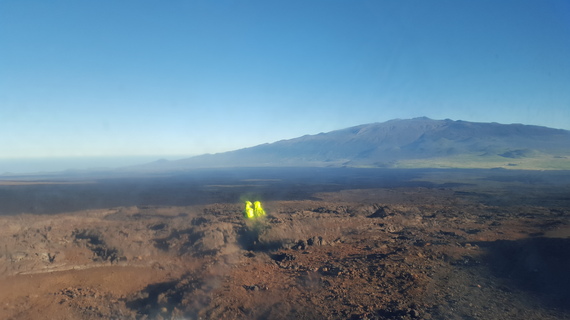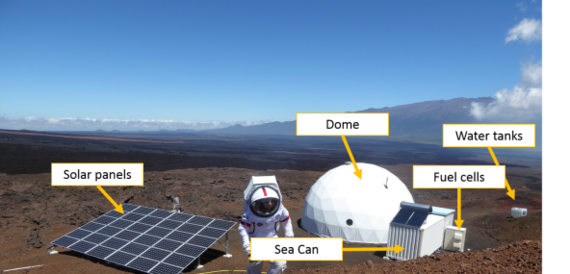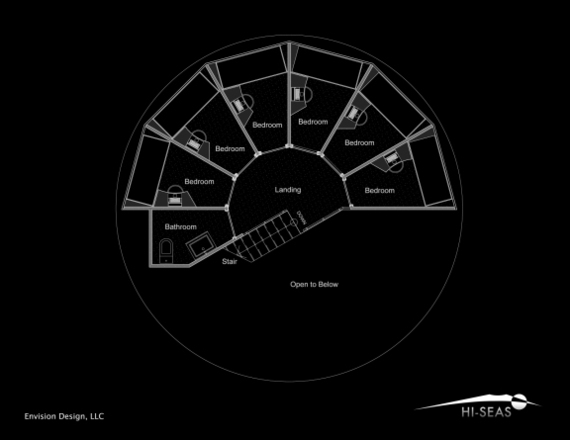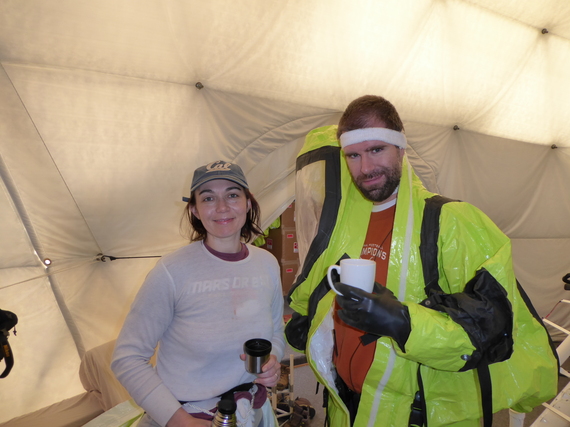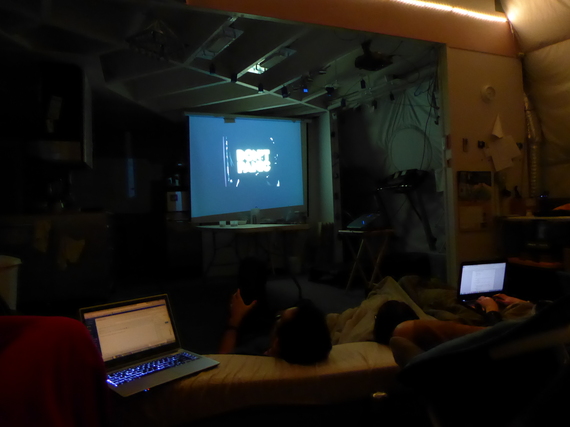The Chief Medical Officer and the Chief Engineer look out over the valley while awaiting further orders from ground control. Photo taken out the window of the HI-SEAS hab by Tristan Bassingthwaighte.
Welcome to the 42nd day of NASA's longest simulated Mars mission! The day started with a bang. Or rather, a whimper. The whimper was the sound of our power systems almost dying.
Don't panic.
At roughly 6:35 a.m. Martian Standard time, I was standing in front of UILA, our version of the Starship Enterprise's control panel, holding a camping mug full of almost-hot tea, wondering why the hab was down to 8 percent power. 12 hours prior, after a relatively sunny day, we had been closer to 80 percent. How had we dropped more than 70 percent power in less than 12 hours?
Strangely enough, on purpose.
Earlier the previous day, we had received notice of an incoming hydrogen delivery. The hab runs on solar power upwards of 90 percent of the time, but on dark days, we dip into a backup supply of hydrogen that lives in the fuel cell supply tanks. With an incoming supply due to land the next day, mission control sent over orders to burn through the hydrogen still in storage as quickly as possible.
Don't panic.
Instead, do something completely different. In our case, take the usual routine -- working in the near-darkness under dim LEDs, cooking before nightfall, running when the sun is at its brightest -- and turn it on its head. Instead of running on the treadmill at 11 a.m., we ran at 8 p.m. We cooked after the sun went down. Cooking in the dark! I hadn't done that in, well, 41 days.
So we cooked and cleaned and ran in the dark until we were lower on stored solar power than we had been on any previous night in the mission. It was unnerving to see just how quickly those numbers dropped. But it was all per the plan. Per the plan, we would be running on hydrogen when the fresh supply arrived. The old tanks would run low, and we would swap in the new ones.
So, why, 12 hours later, were we down to 7 percent power and falling?
For those of you who don't live in a dome on a simulated planet, at 5 percent battery we have about 30 minutes before we're completely out of power. What's at stake in a power loss on simulated Mars? Fortunately, not air pressure or oxygen. Unfortunately, heat. At 9,000 feet in October, that can be a problem. At the same time, refrigeration goes. This isn't an issue for human food supplies -- our food is shelf-stable -- but it is a problem for the scientists for whom we've been collecting refrigerated samples. Samples of what? Well, of us, of course. Of our various bit and pieces, hair and skin bacteria and fluids, during different stages of the mission. So, science might be lost. Heat would go. But what's the worst thing of all that would befall the HI-SEAS crew if the power failed?
The composting toilet fans would die and the hab would rapidly fill up with the resulting fumes.
Panic in 3, 2, 1...
At 6 percent power I walked up the stairs to the living quarters and woke up the Chief Engineer. Like the most committed, hard-working people -- doctors, nurses, firemen, paramedics, heads of state, parents of small children -- when it's really important, the Chief doesn't mind if we come knocking.
"I'm sorry to wake you," I said into the darkness of his bunk, "but the hab is at 6 percent power and dropping."
He didn't mind.
Since our first weeks on the mission, we've been running drills to see how fast we can don our suits and get ready to head out the door. At first, we took an abysmal ~20 minutes. Then, it was closer to 15. During the last drill, we were nearly down to 5.
Just a shade before 7 a.m., with no tea in one crewman and only 1/2 a cup in the other, the Chief Engineer and I were suited up in the airlock with the decompression cycle running.
It was, all things considered, a beautiful morning. The recently dropped hydrogen tanks were laying peacefully on the dry red earth. The sun was making Mauna Kea with its slim crown of observatories shine in the distance as we popped open the flat gray fuel cell case. No leak could be detected. Nonetheless, a glowing red light told us that the system was offline in a major way. You know those big red buttons in the movies that you are never supposed to press -- not until the appropriate point of dramatic tension has been reached and all is about to be lost? We pressed them both.
Sadly, it didn't help.
Fortunately, help was coming, quite literally, over the horizon. Behind us, the white-capped observatories across the valley were glowing in the morning sun. For a mostly-solar-powered mission, that means everything. As we struggled in vain to convince the hydrogen backup system that no, really, it wanted to come online, our super-high-efficiency solar panels yawned, stretched, and kicked into action. Though the fuel cell system remained offline, the main batteries started charging from the solar array. The commander flagged us back inside the hab while mission control tried to diagnose the problem from the ground. As the chief and I stood in our chilly suits waiting for the 5-minute recompression cycle to end, I radioed into the hab asking if we had enough power to cook, and, more importantly, to make tea.
"Negative," was the reply.
Space exploration is powered on gumption, duct tape, and tasty beverages, typically caffeinated ones. Which is why I make a canteen of tea every day at sundown. Tea is like your towel: you don't want to leave the planet without it. I had enough in the canteen this morning for the chief and I to have one cup apiece. Thanks to the sun, we were cooking by 8:30. Around 9:30, ground control asked the crew to EVA again. Around 10:30, we pulled a bum fuel cell out of the system. This should fix the problem.
Should fix it. We'll find out in ~6 hours, a little after 4 a.m. Between now and then.
